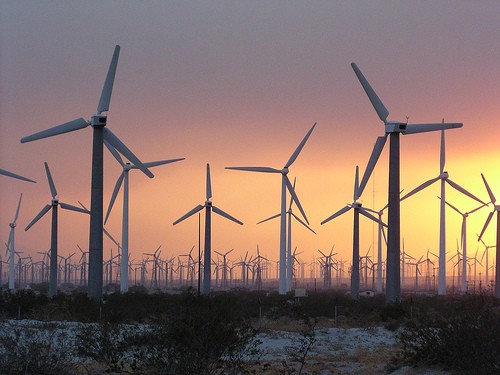Investment in Wind Power_1
Post on: 6 Апрель, 2015 No Comment

Investment in Wind Power
One of the most important economic benefits of wind power is that it reduces the exposure of our economies to fuel price volatility. This coupled with the concern over greenhouse gas emissions, has prompted political attention on energy alternatives, and one of the most prominent ones has been wind power. Wind energy already plays a significant role in several European nations, and countries like China and India are rapidly expanding their capacity both to manufacture wind turbines and to integrate wind power into their electricity grids.
Today’s wind industry is notably different from that in the early 1980s. Wind turbines now are typically 100 times more powerful than early versions and employ sophisticated materials, electronics, and aerodynamics. Costs have declined, making wind more competitive with other power generation options. Large companies and investment banks now drive most wind power activity compared to the early days of collaborating scientists, inventors, and entrepreneurs.
Numerous complex variables affect the economics of wind power. This includes a financial analysis that compares the cost of building and operating wind plants with competing technologies (coal, natural gas, and nuclear power). A comprehensive analysis for a specific project would take many other factors into consideration, including the cost of any necessary transmission upgrades and other options (e.g. purchased power or demand reduction). Approximately 75% of the total cost of energy for a wind turbine is related to upfront costs such as the cost of the turbine, foundation, electrical equipment, grid-connection and so on. Obviously, fluctuating fuel costs have no impact on power generation costs. Thus a wind turbine is capital-intensive compared to conventional fossil fuel fired technologies such as a natural gas power plant, where as much as 40-70% of costs are related to fuel and O&M.
Investing in renewable energy is an attractive opportunity to invest in a growing and dynamic market, as well as a way to be actively involved in the many exciting developments in the market for green energy. In some cases, the most convenient way for to support wind power development is by participating in green power programs.
In terms of major companies in wind, entities like Vestas and Nordex, are dedicated wind turbine manufacturers. Others, like GE and Siemens, participate in the wind industry in a big way, but as a nominal (but growing) part of their businesses. This is a major fact to consider when investing solely in wind energy, as you will want to take stakes in companies that derive the bulk of their income from wind-related activities.
Aruvian’s R’search presents a research report on Investment in Wind Power. This report takes a look at what all is going on in terms of investing in wind power. Starting with the economics of wind power which gives an overview of cost and operating characteristics, electrical grid connections, and the basic cost of wind energy, the report looks at the price of wind energy, wind operation and system integration issues and how these impact the economics of wind power, and also contains a primer to investing in wind power. The primer acts as a primary guide to purchasing wind power and on site renewable energy generation.
Moving on further, the report takes a look at how to ensure a profitable wind investment in relation with government incentives and keeping in mind the unpredictable nature of wind energy. The report also analyzes the ISE Global Wind Energy Index, along with financing options for wind energy such as feed in tariffs, renewable energy tariffs, etc.
An entire section is dedicated to analyzing the value of wind energy as compared to conventional generation. Further, major regions in wind power investment such as China, India, the United States, and many other countries are analyzes in terms of wind energy industry developments, investment in wind power in these regions, and other factors.
Companies that are operating in the wind energy industry and their portfolios are also analyzed in this comprehensive research report on Investment in Wind Power.
A. Executive Summary
B. Introduction to Wind Power
B.1 A Clean Green Energy — Wind Power
B.1.1 What is Wind Power?
B.1.2 How does it Work?
B.2 Brief History of Wind Power
B.3 Electricity from Wind
B.4 How do Wind Turbines Work?
B.5 Wind Power Technology
B.5.1 Physical Relationships
B.5.2 Types of Wind Turbines
B.5.3 Capacity Factor
B.5.4 Wind Turbine Costs
B.5.5 Technical Lifetime of Wind Turbines
C.4.1 Lower Electricity Bills
C.4.2 Control over Power Cost
C.4.3 Being a Green Business
C.5.2 Topography and Accessibility
C.5.3 Surface Roughness

C.5.4 Distance to Transmission Lines
C.5.5 Right Size and Height
C.6 Wind Resource and Power Generation
D. Investing in Wind Power
D.1 Introduction
D.2 Economics of Wind Power
D.2.1 Cost and Operating Characteristics of Wind Power
D.2.2 Electrical Grid Connection
D.2.3 Other Project Development and Planning Costs
D.2.4 Basic Cost of Wind Energy
D.3 Price of Wind Energy
D.4 Wind Operation and System Integration Issues
D.5 Levelized Cost Comparison
D.6 Investment in Clean Energy Technologies
D.7 Primer to Investing in Wind














